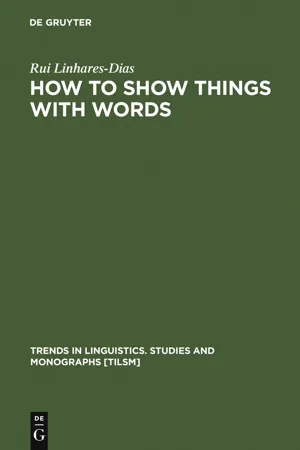
- 566 pages
- English
- PDF
- Available on iOS & Android
How to Show Things with Words
About This Book
How to Show Things with Words is an interdisciplinary research study at the interface between linguistics and philosophy which sheds new light on the narrative-theoretical issue of proximal vs. distal stance adoption in discourse.
Narrative distance ultimately depends on the epistemological source of the information conveyed, but English and other Indo-European languages have no inflectional systems for (en)coding that source of knowledge. To fill in the gap, speech act theory is (re)considered in the light of philosophical research on linguistic functions and a parallel is drawn between grammaticalized evidential categories and the objectifying acts of Husserl's phenomenology of constitution. These intuitive vs. signitive intentional acts do, indeed, roughly correspond to direct vs. indirect evidentiary forms and can be inferred from the temporal-perspectival organization of discourse by the so-called intimation or announcement function of language-systems. It turns out that perspectival immediacy requires tenses with overlapping event- and reference-points, but predictions of the sort are non-monotonic forms of reasoning defeasible by quantificational aspect distinctions, on the one hand, and inherent meaning considerations, on the other. To substantiate this claim, the bulk of the book provides an in-depth formal semantic account of tense, aspect and Aktionsart, interwoven with a detailed analysis of the cognitive processes associated with eventuality-description types.
The book adresses an audience of linguists in general, formal semanticists, cognitive scientists, philosophers and narratologists with an interest in natural language semantics.
Frequently asked questions
Information
Table of contents
- Preface
- List of figures
- List of tables
- Abbreviations
- Introduction
- Part 1: Prolegomena
- 1. The linguistic structure of narrative transmission
- 1.1. Introduction
- 1.2. The showing-telling distinction
- 1.3. Narrative transmission as cognitive distance: From evidential modalities to indication signs
- 1.4. The role of tense, aspect and ‘Aktionsart’
- 1.5. Concluding remarks
- 2. Linguistics in narratology: A critical historical survey
- 2.1. Introduction
- 2.2. Ingarden, Stanzel, Hamburger: The neutralization of the ‘episches Präteritum’ as a past-tense form
- 2.3. Müller: Quantitative indicators and beyond
- 2.4. Weinrich’s textlinguistic theory: A tense-centered approach to backgrounded narrative discourse
- 2.5. Uspensky: Synchronic and retrospective viewpoints as a function of tense and aspect oppositions
- 2.6. Barthes: The semiotics of ‘L’effet de réel’
- 2.7. Chatman and Prince: ‘Aktionsart’ revisited
- 2.8. Caenepeel: Perspectivally situated vs. perspectivally non-situated sentences
- 2.9. Chafe: Displacement and immediacy in conversational language vs. displaced immediacy in narrative fiction
- 2.10. Concluding remarks
- 3. The narrating stance as locutionary subjectivity
- 3.1. Introduction
- 3.2. Speech-act theory and narrative discourse
- 3.3. The philosophical research on linguistic functions
- 3.4. The phenomenological make-up of the narrating stance as locutionary subjectivity
- 3.5. Locutionary subjectivity as a function of tense, aspect and ‘Aktionsart’
- 3.6. Summary and conclusion
- Part 2: The temporal-perspectival organization of discourse
- 4. Tense
- 4.1. Introduction
- 4.2. Reichenbach’s theory of tense
- 4.3. Tense in narrative discourse
- 4.4. Tense, perception and memory
- 4.5. Concluding remarks
- 5. Aspect
- 5.1. Introduction
- 5.2. Classificatory systems of aspectual oppositions
- 5.3. Viewpoint aspect and point of view: A first view on the role played by imperfective meaning
- 5.4. Imperfectivity as a two-edged aspectual form or another view on viewpoint aspect and point of view
- 5.5. A note on iterativity
- 5.6. Concluding remarks
- 6. Aktionsart
- 6.1. Introduction
- 6.2. Vendler’s aspectual classes
- 6.3. Formal semantic approaches to ‘Aktionsart’
- 6.4. Concluding remarks
- 7. The effects of Aktionsart on narrative transmission
- 7.1. Introduction
- 7.2. -STAT eventuality descriptions
- 7.3. +STAT eventuality descriptions
- 7.4. World-knowledge based event semantics
- 7.5. Concluding remarks
- Conclusion
- Appendix 1
- Appendix 2
- Notes
- References
- Index of names
- Index of subjects